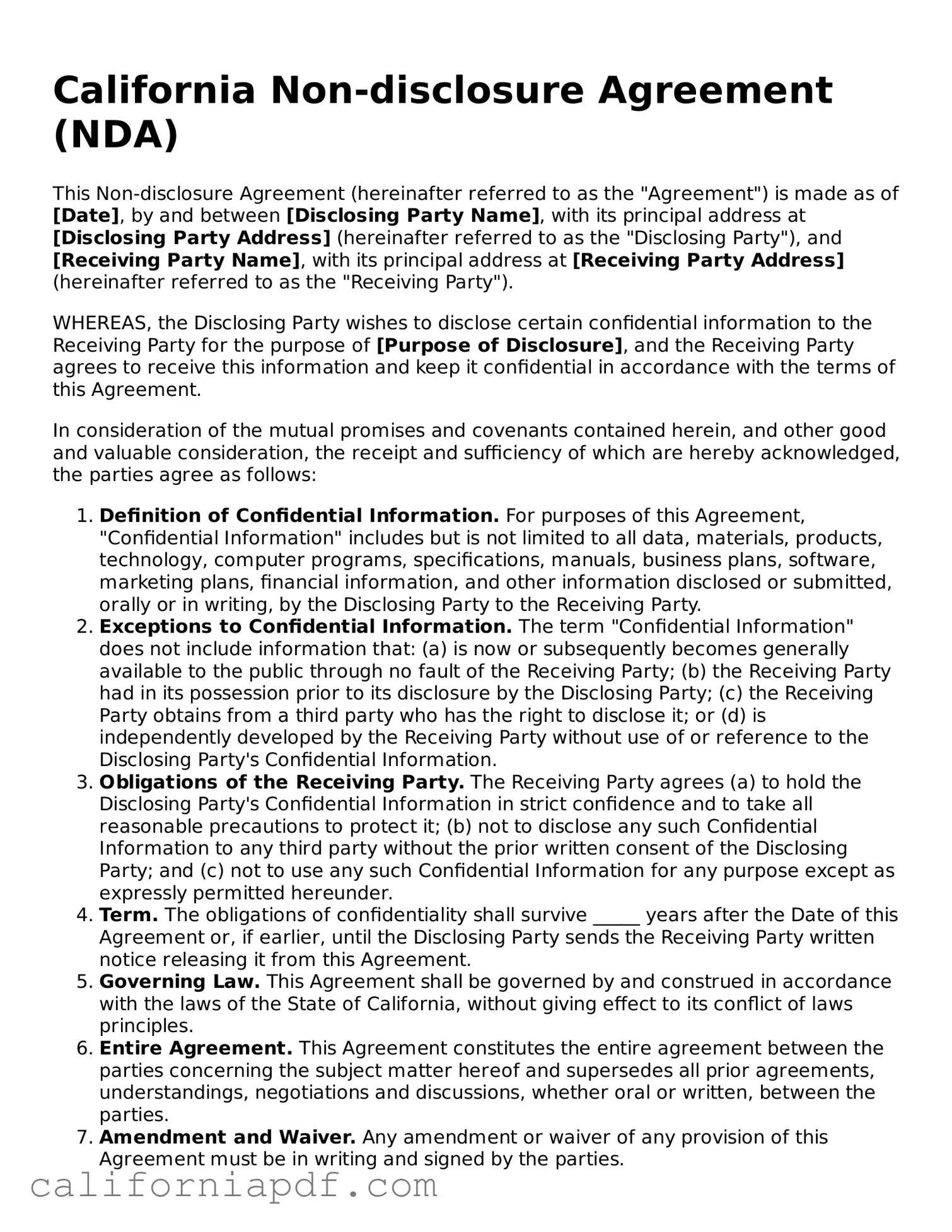California Non-disclosure Agreement (NDA)
This Non-disclosure Agreement (hereinafter referred to as the "Agreement") is made as of [Date], by and between [Disclosing Party Name], with its principal address at [Disclosing Party Address] (hereinafter referred to as the "Disclosing Party"), and [Receiving Party Name], with its principal address at [Receiving Party Address] (hereinafter referred to as the "Receiving Party").
WHEREAS, the Disclosing Party wishes to disclose certain confidential information to the Receiving Party for the purpose of [Purpose of Disclosure], and the Receiving Party agrees to receive this information and keep it confidential in accordance with the terms of this Agreement.
In consideration of the mutual promises and covenants contained herein, and other good and valuable consideration, the receipt and sufficiency of which are hereby acknowledged, the parties agree as follows:
- Definition of Confidential Information. For purposes of this Agreement, "Confidential Information" includes but is not limited to all data, materials, products, technology, computer programs, specifications, manuals, business plans, software, marketing plans, financial information, and other information disclosed or submitted, orally or in writing, by the Disclosing Party to the Receiving Party.
- Exceptions to Confidential Information. The term "Confidential Information" does not include information that: (a) is now or subsequently becomes generally available to the public through no fault of the Receiving Party; (b) the Receiving Party had in its possession prior to its disclosure by the Disclosing Party; (c) the Receiving Party obtains from a third party who has the right to disclose it; or (d) is independently developed by the Receiving Party without use of or reference to the Disclosing Party's Confidential Information.
- Obligations of the Receiving Party. The Receiving Party agrees (a) to hold the Disclosing Party's Confidential Information in strict confidence and to take all reasonable precautions to protect it; (b) not to disclose any such Confidential Information to any third party without the prior written consent of the Disclosing Party; and (c) not to use any such Confidential Information for any purpose except as expressly permitted hereunder.
- Term. The obligations of confidentiality shall survive _____ years after the Date of this Agreement or, if earlier, until the Disclosing Party sends the Receiving Party written notice releasing it from this Agreement.
- Governing Law. This Agreement shall be governed by and construed in accordance with the laws of the State of California, without giving effect to its conflict of laws principles.
- Entire Agreement. This Agreement constitutes the entire agreement between the parties concerning the subject matter hereof and supersedes all prior agreements, understandings, negotiations and discussions, whether oral or written, between the parties.
- Amendment and Waiver. Any amendment or waiver of any provision of this Agreement must be in writing and signed by the parties.
- Severability. If any term or provision of this Agreement is found by a court of competent jurisdiction to be invalid, illegal, or otherwise unenforceable, the same shall not affect the other terms or provisions hereof or the whole of this Agreement, but such term or provision shall be deemed modified to the extent necessary in the court’s opinion to render such term or provision enforceable, and the rights and obligations of the parties shall be construed and enforced accordingly, preserving to the fullest permissible extent the intent and agreements of the parties herein.
IN WITNESS WHEREOF, the parties hereto have executed this Agreement as of the date first above written.
Disclosing Party: ________________________
By: _____________________________________
Title: __________________________________
Date: ___________________________________
Receiving Party: ________________________
By: _____________________________________
Title: __________________________________
Date: ___________________________________
